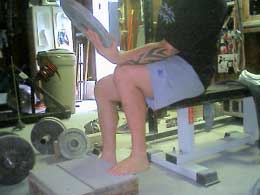
An Article by Rick Walker from www.dieselcrew.com
“Whether you are grappling with or without the gi, grip strength is a huge asset for Brazilian jiu-jitsu, submission grappling and mixed martial arts (MMA). This article from Dieselcrew focuses on developing grip strength in a law-enforcement and corrections context, but is still great information for those of us focusing on coming to grips with our opponents on the mat.”
Stephan Kesting
Most of the time, the hands are the first thing to come in contact with someone else. Chances are, if you are in law enforcement or corrections, your hands are used every day. The strength of you hands, wrists, and forearms can either ensure a successful restraint or put you in severe danger if they are your weak link. This article will approach grip from a different view point. Instead of a training routine on how to close grippers, pinch plates, or lift the Inch Dumbbell, I will attempt to explain functional grip training for life or death situations.
Law Enforcement/Corrections
Apprehending, restraining, and detaining a subject. This is the core of your profession. You have to “lay hands” on someone almost every day. In the field of corrections, chances are it IS everyday. Most of the time the subject is going to go quietly. You will have no problems and after 8-10 hours, you can punch out, and head home. Unfortunately, this is not always the case.
When someone makes the decision to fight back, strong hands are going to make all the difference. The ability to grasp and control a subject’s arm will give you the upper hand and protect you from hand strikes and/or striking or stabbing weapons. If you lack the ability to hang onto a fighting subject, you will put yourself and those around you in danger.
When faced with a subject who has made the decision to fight, you are often limited on what to do. Of course, the main objective is to get the subject onto the ground and restrained as quickly as possible. Hand, wrist, and forearm strength will enable you to grab and control the subject, regardless of how you get a hold of them. If all you can grasp is a jacket or shirt, chances are you will still have the subject down in minimum time if your hands are up to the task. You will also be able to apply leg, arm, or neck locks efficiently that the subject will be unable to break.
Strong hands also enable you to restrain the subject quickly. You will be able to control the subject’s arms or legs, which will enable you to apply restraints quickly and safely. Never, ever underestimate the ability to grab an arm and control it quickly. Also, grasping a hand or a wrist and having the ability to apply extreme force, will often calm a subject down for fear of more pain.
Strengthening the Weak Links
Many people will read this article and think repping out on a hand gripper or doing forearm curls is going to do it. Wrong. First we have to look at the weak links, or what type of strength is needed for combat situations. I will start with the most important and work my way down.
Wrist Strength
You can have the strongest hands on the planet, if your wrists are weak, you will fail. People don’t stand still. A fighting subject is going to be flailing around, moving violently and quickly. You may have the hand strength to hold on, but one twist and your weak wrists will let you down.
There are a number of ways to strengthen the wrists and contrary to popular belief, doing barbell wrist curls are not top priority. Remember, we are going for brute, frightening strength here, not muscle size or muscle pump. There are many small forearmed men that could snap your wrist like a twig! Size doesn’t equal strength.
Perhaps the best of the best when it comes to wrist strength is the plate wrist curl. To do this exercise, you take a weight plate, such as a 25 pounder. Grasp the plate with your fingers on the backside, straight, and your thumb hooked over the side facing you. If you have a large hand, make sure to keep the fingers out of the hole in the plate as this makes it easier. Now, while sitting on a bench or chair, rest your arm on your leg with your hand and plate hanging over your knee.
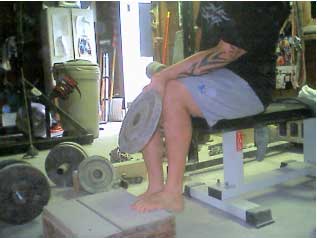
Curl the plate up and twist your wrist so your pinky goes towards your face.

Lower slow and repeat. Make sure to come all the way up and go all the way down. Once you can get 5 sets of 6 reps, it is time to add weight. Do so by clamping smaller plates onto the outermost edge of the plate you are using. A good plate wrist curl is a 25 pounder. An outstanding plate wrist curl is a 35. If you can handle a 35 pounder in a strict plate wrist curl, there will be very few men who will have stronger wrists, regardless of size. As you will soon experience, this exercise not only works the wrist and forearms, but hits the fingers and thumbs extremely hard as well. The fingers will toughen up from forcing them to remain straight in order to curl the plate. Basically, this is an all around great exercise.
There is another way to do this exercise that takes it to a whole new level. Use a 2×4 cut to a length larger then an Olympic 45 pound plate. Drive a 60-penny nail into the end of the board. For some added protection from slivers, wrap some duct tape around the end of the board that you will be grasping. Now, put a small plate on the nail, grasp the other end, and perform the plate curl as described above. On a long board, a 5-pound plate is impressive. Using 10 or more pounds will have you close to plate curling a 45!
The second best wrist strengthener is levering. Levering can take many forms. Normally, when one thinks of levering, they think of sledgehammers. Grasp a sledgehammer by the bottom of the handle (if you are just starting out-use a 6-pound hammer) hold the hammer out to your side with the hammerhead up and your arm straight.
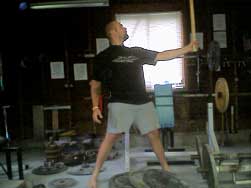
Now, while keeping the arm straight and level, lower the hammerhead down to your forehead, and then back up.
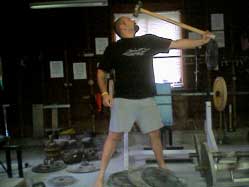
A good strict hammer lever is a 10-12 pounder. Some freaks can lever hammers that weight 30+ pounds! This exercise is going to wreck your entire arm from the shoulder down!
You can also do this by holding the hammer out in front of you or straight out behind you, and then levering it up and down.
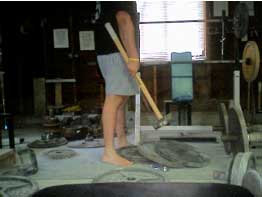
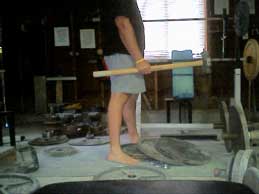
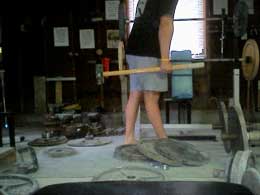
Another must is to lever the hammer by choking up on it and levering it side to side.
Add a special twist to the hammer lever by using pvc pipe. I use a 2” diameter piece of pipe, and clamp a plate to the end of it via 2 screw clamps. On the other end, I place a third screw clamp. This clamp holds on a 2.5” piece that I use as the “handle”.
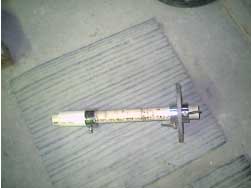
I then lever it side to side.
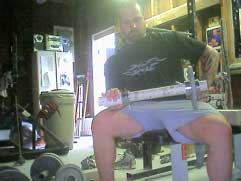
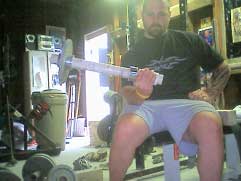
This not only hits the wrists, it works the hand and thumb extremely hard as well.
The final exercise I do is the reverse curl. Now, I don’t do it like a bodybuilder! I use a 2” thick bar, or axle, and go as heavy as possible. This works a variety if wrist and arm structures. It also serves as rehab as you are working the extensors of the wrist, and thus balancing your hand strength. Using the axle bar will hit the hands and thumbs as well.
Thumb Strength
Unfortunately, many people work their hands via hand grippers or holding heavy barbells or dumbbells. This is a great way to strengthen the fingers, but the thumbs are forgotten. You may have fingers of steel, if your thumb is weak, you wont be able to grasp and hold onto a fleeing subject. Plus, a strong thumb can be used to pierce a subject’s pressure points and render them helpless.
I believe that the best way to work the thumbs for combat is to do thick bar work. Arms and legs are thick. When you grasp a body part, chances are there will be a large gap between your fingers and thumb. This means, both parts must be strong to make the chain strong. But, there is another spin on thick bar work that many over look. A regular steel thick bar has no give. The soft tissue of arms and legs gives a little as you squeeze it before you hit bone. To train this, get some foam, or the “puss pad” that people Velcro around the bar when doing squats. Wrap this around the middle of a barbell and now you have a thick bar that gives, much like and arm or a leg. With this, you can do 1-arm deadlifts, tosses from hand-to-hand, snatches, clean and presses, and 1-arm rows. You can even do 2-arm stuff if you get 2 of them. Most athletic companies sell these little wonders for $10 or less. Also, cut one in half and put them on the handles of dumbbells for even more fun. Here is an example of a steel thick bar, and a foam thick bar.
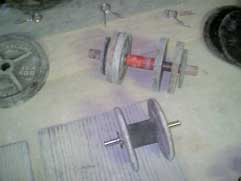
The foam bar in use. You have to squeeze hard to pick it up, just like controlling an arm or leg. I do clean and presses with this, as well as snatches and tosses from hand to hand.
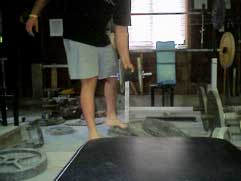
The second exercise that is great for the thumbs is the run-of-the-mill spring clamp. Go to any Home Depot or Lowe’s and you can find the little spring clamps. Get a couple so you have different sizes.
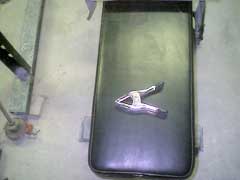
Grasp the spring clamp so one handle is on your index and middle finger and the other handle is on your thumb. Now squeeze. At first you might not be able to move the clamp. If this is the case, use you other hand to cheat it shut, then fight it like hell with one hand. Another great way to train the spring clamp is to squeeze it shut using the index and middle fingers, and thumbs, of each hand and then have some one else grasp the other end and try to pry your hands open.
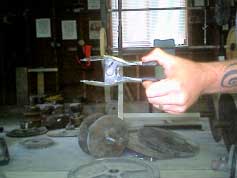
There are some other ways to train the thumb as mentioned above if you want to spend some money to buy equipment. A great piece of thumb equipment I have is The Squeezer© from www.weightlifterswarehoue.com. It works on the same premise as the spring clamp except I can constantly strive to micro-load weights, which allows me to track my progress a little better then with spring clamps alone.
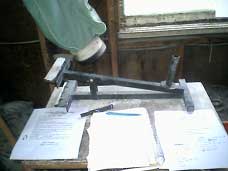
A third way to train the thumbs is to pinch objects. I do not personally think that this translates over to combat as much as the above exercises so I would limit the time spent pinching. However, if you need a little boost in thumb strength, or you are getting bored with your routine, you can start pinching objects. 4x4s, weight plates, chunks of steel, dumbbells, stones, etc. Almost anything that is heavy and awkward can be pinched. Do holds for time, clean and presses, snatches, rows, or farmers walks.
Keep in mind that you can never have thumbs that are too strong! The chain is as strong as the weakest link. Have no weakest links!
Hand/Finger Strength
Your fingers need to be like steel cables if you are in the combat profession. Weak fingers will cause you to let go as soon as the going gets rough! However, there are a number of ways to strengthen the hands and fingers to match the strength of your thumbs and wrists.
The first exercise is one many people know. Just get you run of the mill hand gripper from one of the many suppliers on the net. But, instead of setting the gripper, you are going to do full range movements.
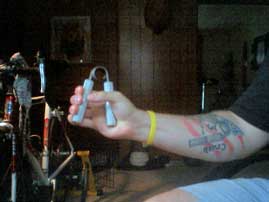

Do not set the gripper. Just grab it, position it in your hand, and then let the working hand to the work. This will work your hand in the open to closed position, which is very important for combat strength.
Another great exercise for the fingers is the curl-up. Simply take a loaded barbell or dumbbell, grasp it so it is just supported by your finger tips, then, using on your fingers, curl the weight up into your hand and squeeze for a 3 count.
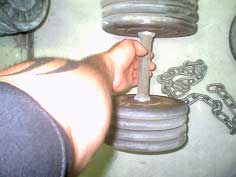
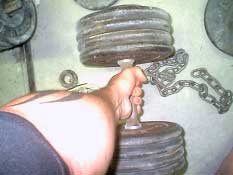
Individual finger lifts are also tremendous finger strengtheners. You can lift weights with individual fingers by using chains, or by grasping the bar. A way I like to do it is bodyweight hangs. I can incorporate abdominal work in this way as well.
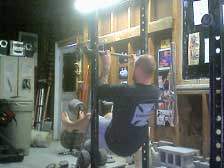
The next exercise I am going to give you is one that I believe is a necessity when it comes to combat strength. My good friend John Wood explained this exercise to me. This guy is a hand strength genius. When he talks, people listen.
Buy yourself an army duffle, or a sturdy canvas type material bag. Fill it with sand, or in my case, dry concrete. So you have something like this.
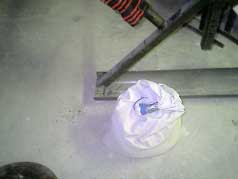
It can be any size or shape. This particular one weighs a little more then 80-pounds and I use it for single hand exercises. I plan on building a bigger one this fall for double hand exercises.
Now, you can either grasp the bag by the loose material, or, if the bag is stuffed full, put an old jacket on the bag and grasp it. Then you just go to work. You can hoist it, throw it overhead, pick it up and slam it into a wall, move it from side to side, anything you want!
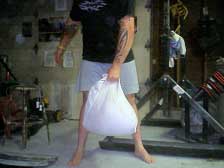
The important part is, it will simulate grabbing someone by their clothes or coat, and then maneuvering them at your will. This will hammer the entire hand! It may hurt your finger tips at first, and even lift up your nails a bit. Ignore it and get used to it. If you have to grab a fleeing inmate or suspect and put them to the ground, you will need this strength.
On a final note, you can do things like jamming your hand into sand or rice, fingertip push-ups, or even rock climbing activities to train your fingers and hands. Mix it up, have fun, and STAY INTENSE!
I hope I have opened your eyes to the importance of hand and arm strength when it comes to combat situations. Doing the exercises listed above will improve your gun accuracy, knife or baton handling skills, as well as your hand to hand combat. If you are someone who deals with the scum of the earth, hand strength is not only recommended, it is a necessity to do your job successfully and to make sure you are safe. If you are someone involved in martial arts, training your grip will take your game to the next level and have you throwing opponents around like yesterdays newspaper.
Regardless of your profession or your hobbies, doing the above workouts will make your hands combat ready. How you incorporate the above exercises is up to you.
Be safe. Be ready.
Rick Walker is a grip-strength enthusiast and writes for www.dieselcrew.com


